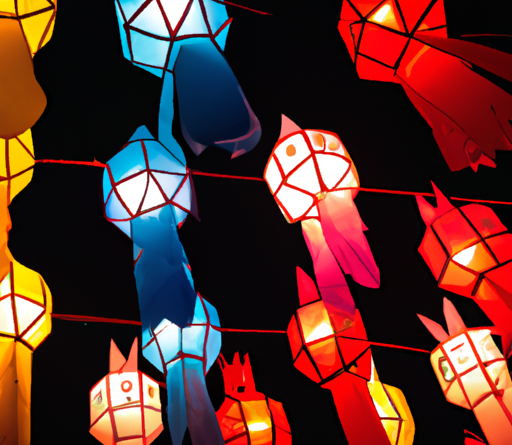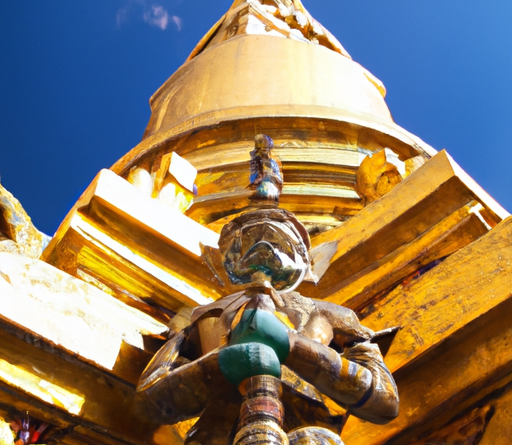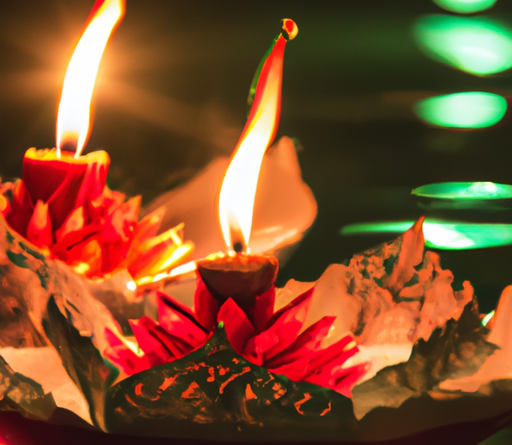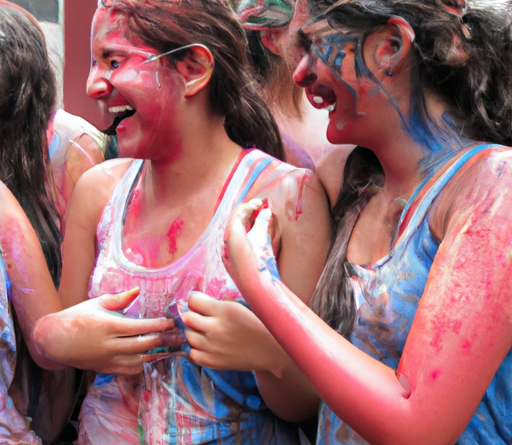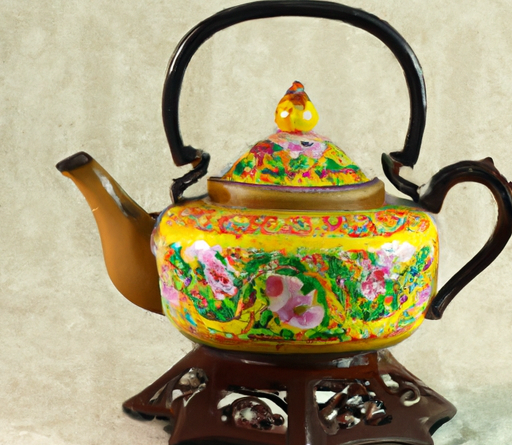
Thailand, a land of rich cultural heritage and vibrant traditions, invites you to embark on a fascinating journey of exploration. From the graceful wai greeting to the enchanting art of Muay Thai, this captivating country is brimming with customs waiting to be discovered and mastered. Immerse yourself in the warm embrace of Thai hospitality and allow yourself to be enthralled by the beauty and intricacies of these cultural traditions. Are you ready to embrace the charm and grace of Thailand’s unique customs?
Introduction
Welcome to the vibrant and culturally-rich country of Thailand! In this comprehensive article, we will delve into various Thai cultural traditions and customs that will make your trip to this beautiful country even more unforgettable. From understanding Thai greetings to exploring the exquisite Thai cuisine, from visiting majestic Buddhist temples to immersing yourself in lively festivals and celebrations, we will cover it all. So, let’s embark on this cultural journey together and learn how to navigate and respect the traditions of Thailand!
Greetings and Wai
Understanding Thai Greetings
As you make your way through the streets of Thailand, you will notice how warm and friendly the Thai people are. A simple greeting can go a long way in establishing connections and building relationships. The most common greeting you will come across is “Sawasdee,” which means “hello” in Thai. In addition to “Sawasdee,” you can also use “Sawasdee krub” if you are male or “Sawasdee ka” if you are female to show respect.
The Wai Gesture
The Wai gesture is an integral part of Thai culture and is used as a form of greeting, gratitude, and respect. To perform the Wai, place your palms together in a prayer-like position, with your fingers pointing upwards towards your chest. The height at which you hold your hands and the level of bowing your head depends on the status of the person you are greeting. The higher the hands and the lower the bow, the more respectful the gesture.
Etiquette for Using the Wai
When using the Wai gesture, it is important to understand the appropriate situations and who to Wai to. It is customary to Wai when greeting elders, teachers, monks, or anyone in a position of authority. However, if you are not a part of Thai culture, it is generally not expected for you to initiate the Wai gesture. Instead, a polite nod or smile will suffice.
Situations When the Wai is Used
The Wai gesture is not only used for greeting but also in various situations. For example, when visiting temples or other religious sites, Wai towards the sacred objects or images as a sign of respect. Additionally, when expressing gratitude or apology, combining the Wai with the appropriate words will leave a positive impression on the Thai people. It’s important to observe and learn from the locals when and how to use the Wai gesture.
Thai Cuisine and Dining Etiquette
Exploring Thai Cuisine
Thai cuisine is famous worldwide for its unique flavors, fragrant herbs, and exquisite presentation. From spicy Tom Yum Soup to flavorful Pad Thai, you are in for a culinary adventure like no other. Thai food combines the perfect balance of sweet, sour, spicy, and salty flavors, creating a harmonious explosion of taste. exploring the local street food stalls and restaurants will truly immerse you in the Thai culinary experience.
Understanding Table Manners
When dining in Thailand, it’s important to understand and embrace the local table manners. Traditionally, Thais use a spoon and fork to eat, with the spoon in their dominant hand and the fork used to push food onto the spoon. Chopsticks are commonly used for noodle dishes or Chinese-style cuisine. It is considered impolite to eat directly from your fork or to have your spoon or fork touch your mouth.
Thai Dining Etiquette
In Thai culture, meals are often shared and enjoyed in a communal setting, which creates a sense of togetherness and connection. It is customary to wait for the eldest or most senior person to begin eating before you start your meal. Additionally, it is polite to sample a little bit of every dish served, as it shows appreciation for the effort put into preparing the meal. Taking small portions and holding them close to your mouth instead of taking large bites is also considered polite.
Food Sharing Customs
Food sharing is a common practice in Thailand and signifies friendship and generosity. When dining with friends or family, it is common to order multiple dishes and share them amongst each other. This allows everyone to taste a variety of flavors and enhances the sense of community. If you are invited to someone’s home, don’t be surprised if they offer to share their meal with you. Accepting their generosity will be greatly appreciated.
Buddhist Customs and Temples
The Importance of Buddhism in Thai Culture
Buddhism plays a significant role in Thai culture and is deeply ingrained in the daily lives of the Thai people. The majority of Thais are practicing Buddhists, and temples (known as “Wat” in Thai) are scattered throughout the country. The teachings of Buddhism focus on mindfulness, compassion, and the pursuit of inner peace. Understanding the importance of Buddhism will enhance your cultural experience in Thailand.
Visiting Thai Temples
Visiting a Thai temple is not only a spiritual experience but also an opportunity to witness the awe-inspiring architecture and intricate artwork. Temples are considered sacred places and should be treated with respect. Before entering a temple, it is customary to remove your shoes and dress modestly. Avoid wearing revealing clothing or touching any religious artifacts.
Etiquette for Temple Visits
When visiting a temple, remember to speak softly and refrain from engaging in loud conversations or disruptive behavior. Be mindful and observant of the local customs, such as not pointing your feet towards the Buddha image, as it is considered disrespectful. Asking permission before taking photographs is also a courteous gesture and shows respect for the sacred space.
Proper Dress Code for Temples
Respecting the dress code when visiting temples is essential to honor the Thai culture. Both men and women should ensure that their shoulders and knees are covered. Loose-fitting and modest clothing is recommended to maintain a respectful appearance. Carrying a shawl or sarong can be useful to cover exposed skin if needed. By dressing appropriately, you show reverence for the spiritual significance of the temple.
Thai Festivals and Celebrations
Exploring Thailand’s Vibrant Festivals
Thailand is renowned for its vibrant and colorful festivals, which provide a glimpse into the rich cultural heritage of the country. Throughout the year, various festivals and celebrations take place, each with its own unique traditions, rituals, and festivities. From the water-soaked fun of Songkran, the Thai New Year, to the enchanting lantern festival of Loy Krathong, there is always something exciting happening in Thailand.
Songkran, the Thai New Year
Songkran is one of the most important festivals in Thailand and is celebrated with great enthusiasm and joy. It marks the traditional Thai New Year and falls in mid-April. During Songkran, the streets come alive with water fights and playful splashing, symbolizing the cleansing of the old year and preparing for a fresh start. It’s a time to experience the contagious laughter and smiles of the Thai people while staying cool in the midst of the scorching heat.
Loy Krathong, the Festival of Lights
Loy Krathong, also known as the Festival of Lights, is a captivating event that takes place on the full moon night of the twelfth lunar month (usually in November). During this festival, people gather near rivers, canals, and lakes to release small lotus-shaped rafts called “krathongs” onto the water. These krathongs are adorned with candles, incense, and flowers, creating a mesmerizing scene as they float along the waterways. Loy Krathong is a time for Thais to pay respect to the water spirits and let go of the past year’s grievances.
Thai Wedding Traditions
Attending a traditional Thai wedding is a unique cultural experience. Thai weddings are deeply rooted in tradition and customs that date back centuries. From the intricate rituals to the elaborate ceremonies, each step of the wedding reflects the importance of family and community in Thai society. Traditional Thai weddings often involve vibrant processions, colorful attire, and blessings from respected guests. Witnessing a wedding ceremony in Thailand will leave you in awe of the harmonious blend of tradition and modernity.
Traditional Thai Arts and Crafts
Mastering Traditional Thai Dance
Thai dance, with its graceful movements and intricate hand gestures, is a captivating art form that has been passed down through generations. Traditional Thai dance embodies the rich history, mythology, and cultural heritage of the country. From classical dances like the graceful Khon to the lively and energetic Ram Thai, each style has its own unique charm. Attending a traditional dance performance or even trying your hand at learning some basic steps will immerse you in the beauty and elegance of Thai culture.
Thai Boxing (Muay Thai)
Muay Thai, also known as Thai boxing, is not just a sport but a way of life for many Thais. Known for its powerful strikes using various parts of the body, Muay Thai has gained international recognition and popularity. Attending a Muay Thai match or even participating in training sessions allows you to witness the dedication, discipline, and immense skill possessed by the fighters. Embracing the art of Muay Thai will teach you not only self-defense techniques but also invaluable life lessons about respect, determination, and perseverance.
Thai Handicrafts and Artwork
Thai handicrafts and artwork are testament to the creativity and craftsmanship of the Thai people. From intricately carved woodwork to delicate silk weaving, Thai artisans have honed their skills over centuries. Exploring local markets and artisan villages will present you with a wide range of stunning handcrafted items, such as exquisite ceramics, traditional masks, intricately painted umbrellas, and intricately woven fabrics. Taking home a piece of Thai craftsmanship is not only a cherished souvenir but also a testament to the rich cultural heritage of the country.
Thai Traditional Music and Instruments
Thai traditional music reflects the soul and spirit of the nation. The gentle melodies and unique compositions create a serene and enchanting atmosphere. Traditional Thai music is predominantly played using classical instruments such as the khim (a hammered dulcimer), the ranat (a wooden xylophone), and the khrueang sai (a Thai classical orchestra). Attending a traditional Thai music performance will transport you to a world of tranquility and evoke emotions you never knew existed.
Respecting the Monarchy
The Importance of the Thai Monarchy
The Thai monarchy holds a significant place in the hearts of the Thai people, and respecting the royal family is of utmost importance. The monarchy embodies the unity, stability, and deep-rooted traditions of Thailand. It is essential to approach discussions about the monarchy with respect and sensitivity, as it is a sensitive topic in Thai society.
Respecting the Royal Family
When in Thailand, it is important to respect the royal family and refrain from any disrespectful behavior or speech. The Thai people hold great reverence for their monarch, and any form of insult or disrespect towards the royal family is considered highly offensive and can lead to severe legal consequences. Understanding and adhering to the cultural sensitivity surrounding the monarchy will ensure a harmonious and respectful experience in Thailand.
Lèse-majesté Laws
Thailand has strict laws regarding lèse-majesté, which prohibit any form of criticism or defamation of the Thai monarchy. These laws aim to preserve the dignity and respect for the royal family. It is vital to be cautious when discussing topics related to the monarchy, ensuring that you uphold the legal and cultural boundaries. As a visitor, it’s best to avoid discussing the monarchy altogether to prevent any unintentional misunderstandings or legal implications.
Attitudes towards the Monarchy
Thais revere and hold their monarchy in the highest regard. The monarchy is seen as a unifying force and a symbol of national pride. The sight of the royal flag or images of the royal family should be treated with respect. It is not uncommon to witness public displays of affection and admiration for the monarchy, such as pictures or portraits displayed in homes, businesses, and public spaces. By being mindful and respectful of these attitudes, you contribute to the harmonious coexistence in Thai society.
Thai Language and Communication
Basic Thai Phrases and Greetings
While English is widely spoken in tourist areas, learning a few basic Thai phrases will go a long way in enriching your cultural experience and connecting with the locals. Here are a few essential phrases to get you started:
- “Sawasdee” – Hello
- “Khop khun” – Thank you
- “Chai” – Yes
- “Mai chai” – No
- “Nee tao rai?” – How much is this?
- “Suay mak” – Very beautiful
- “Chai mai?” – Is it okay?
Understanding Thai Pronunciation
Thai pronunciation may be challenging for newcomers, but with a little practice, you can improve your language skills and communicate more effectively. Pay attention to tone and pitch, as the Thai language is tonal, meaning that a word’s meaning can change depending on the tone used. It is advisable to learn the five fundamental tones in Thai: high, low, rising, falling, and mid. Listening to native speakers and practicing with locals will help you refine your pronunciation skills.
Non-Verbal Communication in Thailand
Thais often rely on non-verbal cues and gestures to convey their message. It’s important to pay attention to these non-verbal cues to fully understand the context and intention of the conversation. For example, a smile in Thailand can mean different things, ranging from politeness to embarrassment or even unease. Similarly, maintaining eye contact can be interpreted differently compared to Western cultures. Being observant and sensitive to these non-verbal cues will enhance your communication skills and foster meaningful connections.
Cultural Nuances in Thai Language
Learning a few cultural nuances associated with the Thai language will help you navigate conversations with ease. The Thai people greatly appreciate the usage of polite particles such as “krub” (for males) and “ka” (for females) when addressing others, as it signifies respect and politeness. Additionally, Thais often use indirect language to soften their statements and show politeness. Understanding and adopting these cultural nuances will demonstrate your interest in and appreciation for the Thai language and culture.
Thai Fruit Etiquette
Thai-Specific Fruit Etiquette
Thailand is known for its abundance of tropical fruits, and indulging in the variety of flavors and aromas is an integral part of the Thai culinary experience. However, there are specific etiquettes to be aware of when it comes to enjoying fruits in Thailand. For example, it is considered impolite to take the last piece of fruit without offering it to others first. Sharing and generosity are valued, and ensuring everyone gets a chance to taste the delicious fruits is a gesture of goodwill.
Eating and Serving Fruit in Thailand
When serving or eating fruit in Thailand, it is customary to use a fruit knife to slice the fruit into bite-sized pieces before consuming. Sharing the fruit with others by placing a few pieces on their plate is a sign of respect and camaraderie. Thais often enjoy their fruits with a small pinch of salt or a sprinkle of chili powder to enhance the flavors. Embracing the fruit culture in Thailand will delight your taste buds and allow you to fully appreciate the freshness and sweetness of the produce.
Symbolism and Superstitions Associated with Fruit
Fruits hold deep symbolism and superstitions in Thai culture. For example, offering a ripe pineapple to someone is seen as a gesture of friendship and hospitality. In contrast, gifting a pear is considered bad luck, as the word for “pear” in Thai sounds similar to the word “separate.” By acquainting yourself with the symbolism and superstitions associated with fruits, you can ensure your gestures are received positively and convey the intended meaning.
Gift Giving with Fruit
When it comes to gift-giving in Thailand, fruits are often preferred over other traditional presents. Fruits are considered not only a nutritious and delightful offering but also a gesture of well-wishing and good health. When presenting fruit as a gift, it is customary to wrap it in colorful papers or place it in a beautifully crafted basket. This showcases thoughtfulness and adds to the aesthetic appeal of the gift. Offering fruit as a gift is a graceful way to show appreciation and affection towards others.
Conclusion
Congratulations! By exploring this comprehensive guide to Thailand’s cultural traditions, you are now equipped with valuable knowledge to navigate and respect the customs of this beautiful country. From understanding Thai greetings and the Wai gesture to exploring the tantalizing Thai cuisine, from immersing yourself in Buddhist customs and visiting temples to embracing the vibrant festivals and celebrations, you have delved deep into the heart of Thai culture. By respecting the monarchy, mastering the basics of the Thai language, and appreciating the symbolic value of fruit, you will undoubtedly leave a positive and lasting impression on the Thai people. So, pack your bags, open your heart, and embark on a cultural journey that will forever enrich your life. Sawasdee ka!


